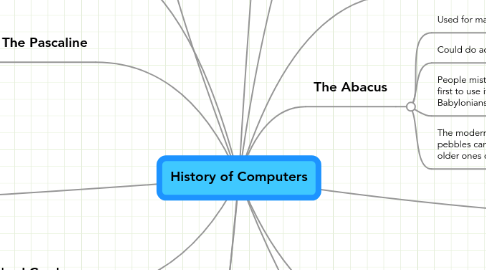
1. The Logarithm
1.1. 1617 created by John Napier
1.2. Could be used to do mulitiplication
1.3. Led to the "Slide Rule"
1.3.1. First built in 1632
1.3.2. In the 1960's was used by the Nasa engineers
1.3.2.1. New node
2. The Pascaline
2.1. 1642 created by Blaise Pascal, at age 19
2.2. Created it to help his father who was a tax collector
2.3. Could only add
2.3.1. Didn't sell a lot because of the price
2.3.2. Wasn't as accurate
3. Punched Cards
3.1. 1801 Joseph Marie Jacquard invented a power loom
3.2. Had your name, adress, phone number etc on it
3.3. Your gas bill would come with a punch card
3.4. Had your name, adress, etc
4. Difference Machine
4.1. Created by 1822 Charles Babbage
4.2. Machine was the size of a room
4.3. Had government funding, which costed a lot of money
4.4. Was never finished because of money issues
4.5. Analytic Engine
4.5.1. Large as a house, powered by 6 steam engines
4.5.2. Punched cards were used
4.5.3. The 2 main parts were the "store" and the "mill"
4.5.3.1. Today this is called the memory unit, and the central processing unit (CPU)
5. Hollerith Desk
5.1. Had a card reader
5.2. Sensed the holes in the cards
5.3. Gear driven mechanism
5.4. Large wall of dial indicators shows the count
5.5. Census machine was the first machine ever to be on a magazine cover
6. Grace Hopper
6.1. 1953 she created the first high level language "flow matic"
6.2. Compiler
6.2.1. Program used to translate things into binary language
7. Apple 1
7.1. Steve Wozniack created the Apple I
7.2. Could be plugged into your tv
7.3. Had a keyboard
7.4. They were sold for about $500 each
8. All Digital Computers
8.1. ENIAC
8.1.1. Stands for Electronic Numerical Integrator and Calculator
8.1.2. Built in the University of Pennsylvania
8.1.2.1. Built between 1943 and 1945 by John Mauchly and J. Presper Eckert,
8.1.3. Big machine that filled up a 20 by 40 ft room
8.1.4. Weighed 30 tonnes
8.1.5. Used over 18,000 vacuume tools
8.1.6. Rooms had to be air conditioned because machines would use a lot of power which generated a lot of heat
8.1.7. Could only hold 20 numbers at a time
9. The Abacus
9.1. Used for mathematical calculations
9.2. Could do addition and subtraction
9.3. People mistaken the Chinese for being the first to use it when it was really the Babylonians
9.4. The modern ones have rods where the pebbles can slide back and forth, while the older ones don't have the rods
10. Calculating Clock
10.1. Invented by Wilhem Schickard in 1623
10.2. First gear driven calculating machine
10.3. Didn't get a lot of publicity because Wilhem died right after he created it
11. Stepped Reckoner
11.1. Created by Gottfried Wilhelm Leibniz
11.2. It could add, subtract, divide, and multiply
11.3. He was the first one to use the binary system
11.4. He died poor
12. Mark 1 Computer
12.1. Partnership between havard and IBM in 1944
12.1.1. IBM
12.1.1.1. Hollerith built a company called Tabulating Machine Company
12.1.1.2. Later renamed to International Business Machine (IBM)
12.1.1.3. This business grew rapidly
12.1.1.4. Began to create mechanical calculators for business sales
12.2. First digital computer created in the US
12.2.1. Weighed 5 tons
12.2.2. 500 miles of wire
12.2.3. 8 ft tall and 51ft long
12.3. Ran non stop for 15 years
12.4. Waterpowered
12.5. Could only store 72 numbers
12.6. Calculated digits that were 23 digits long
13. J.V Atanasoff
13.1. Built a digital computer
13.1.1. Colossus
13.1.1.1. Built during World War 2 by Britain
13.1.1.2. Built it to break cryptographic codes used by Germany
13.1.1.2.1. Zuse
